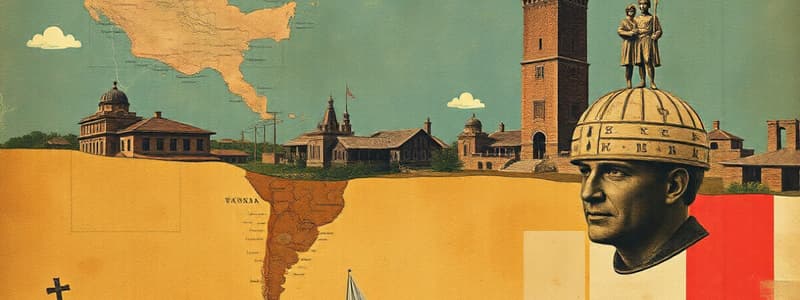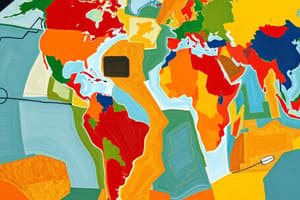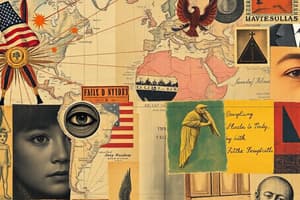Podcast
Questions and Answers
Which of the following plants, originating from the Americas, significantly contributed to population growth in Africa and Asia?
Which of the following plants, originating from the Americas, significantly contributed to population growth in Africa and Asia?
- Maize (corn) (correct)
- Coffee
- Sugar cane
- Wheat
The Columbian Exchange only involved the transfer of goods from the Americas to Europe.
The Columbian Exchange only involved the transfer of goods from the Americas to Europe.
False (B)
What economic policy promotes strengthening a nation by expanding its trade and accumulating wealth?
What economic policy promotes strengthening a nation by expanding its trade and accumulating wealth?
Mercantilism
A rise in prices and an increase in available cash leads to a situation called ______.
A rise in prices and an increase in available cash leads to a situation called ______.
Match the following items to their hemisphere of origin during the Columbian Exchange:
Match the following items to their hemisphere of origin during the Columbian Exchange:
Which factor was most crucial to the transformation of Native American culture on the Great Plains?
Which factor was most crucial to the transformation of Native American culture on the Great Plains?
Mercantilist policies encouraged free trade between a home country and its colonies.
Mercantilist policies encouraged free trade between a home country and its colonies.
What precious metals did traders seek in exchange for goods, according to mercantilist principles?
What precious metals did traders seek in exchange for goods, according to mercantilist principles?
The economic system in which businesses are privately owned and operated for profit is known as ______.
The economic system in which businesses are privately owned and operated for profit is known as ______.
Match each term with its correct definition:
Match each term with its correct definition:
What was a primary driver of the Price Revolution in 16th-century Europe?
What was a primary driver of the Price Revolution in 16th-century Europe?
The price revolution primarily harmed landowners and benefited peasants.
The price revolution primarily harmed landowners and benefited peasants.
The economic changes which saw peasants no longer farming the lord's land in exchange for part of the crop led to what change?
The economic changes which saw peasants no longer farming the lord's land in exchange for part of the crop led to what change?
During the Price Revolution, people had more of it, but there were fewer things available, which drove up prices. The 'it' is ______.
During the Price Revolution, people had more of it, but there were fewer things available, which drove up prices. The 'it' is ______.
What did the English merchant, Thomas Mun, suggest about mercantilism?
What did the English merchant, Thomas Mun, suggest about mercantilism?
The Dutch and the English economies transitioned away from the traditional economy to a market economy.
The Dutch and the English economies transitioned away from the traditional economy to a market economy.
Name three kinds of exchanges that took place through the Columbian Exchange.
Name three kinds of exchanges that took place through the Columbian Exchange.
Under capitalism, farmers benefit from working for landowners and making _____ that enable them to buy goods such as food and clothing.
Under capitalism, farmers benefit from working for landowners and making _____ that enable them to buy goods such as food and clothing.
According to the text provided, approximately how much more expensive was a tulip bulb than an average painting in The Netherlands in the 1630s?
According to the text provided, approximately how much more expensive was a tulip bulb than an average painting in The Netherlands in the 1630s?
Dutch capitalists founded printing, diamond-cutting, sugar-refining, and uranium enrichment industries.
Dutch capitalists founded printing, diamond-cutting, sugar-refining, and uranium enrichment industries.
Flashcards
Columbian Exchange
Columbian Exchange
The global exchange of people, goods, and ideas that began with Columbus's voyages.
Mercantilism
Mercantilism
Economic policy promoting national strength through trade, aiming to maximize wealth.
Capitalism
Capitalism
An economic system where businesses are privately owned and operated for profit.
Cottage Industry
Cottage Industry
Signup and view all the flashcards
Traditional Economy
Traditional Economy
Signup and view all the flashcards
Market Economy
Market Economy
Signup and view all the flashcards
Inflation
Inflation
Signup and view all the flashcards
Landowners benefit
Landowners benefit
Signup and view all the flashcards
Rapid population growth
Rapid population growth
Signup and view all the flashcards
Which benefits more from mercantilism
Which benefits more from mercantilism
Signup and view all the flashcards
Study Notes
- The voyages of discovery started a global exchange of people, goods, and ideas
- European nations embraced the concept of mercantilism
- Economic changes in Europe led to the development of capitalism
The Columbian Exchange
- Columbus's voyages linked the Americas to the rest of the world
- People, plants, animals, diseases, and ideas were exchanged between the Eastern and Western Hemispheres
- Plants from the Americas altered eating habits and increased global population
- Maize, or corn, led to population growth in Africa and Asia
- Peanuts became a staple crop in Africa
- Potatoes, manioc, beans, and tomatoes were also important crops
- Plants from the Eastern Hemisphere also changed life in the Americas
- Sugar cane became a major profit source in the Caribbean and Brazil
- Ranchers in the Americas used grains like barley and oats
- New crops like rye, rice, grapes, bananas, and coffee also transformed the Western Hemisphere
- Soon after the first wave of European settlers came enslaved Africans
- A larger migration in the 1800s brought more than 50 million people from all across Europe to settle in the Americas
- People from Asia also came to the Americas by the thousands, starting in the 1800s
- North America and South America have diverse societies as a result
The Arrival of Horses
- The conquistadors who arrived in the Americas brought horses.
- The Spanish ranchers rode horses and used them to herd cattle.
- Columbus introduced horses, cows, pigs, goats, and chickens to the Americas on his second voyage.
- Horses and cows thrived on the pampas, or grassy plains, of South America
- Some native groups from the North American Great Plains stopped farming and began hunting buffalo from horseback
- They used horses and European guns in warfare
- The first cowboys in the New World were South American gauchos and North American vaqueros
- Some exchanges happened by accident
- European diseases had a deadly effect on the people of the Americas
- The Columbian Exchange led to shared technologies between the hemispheres
Mercantilism
- Mercantilism is an economic policy that promotes strengthening a nation by expanding its trade
- The goal is to bring as much wealth as possible into the country and make it powerful
- Merchants pursued this goal by selling goods in exchange for gold and silver
- Mercantilists urged lawmakers to adopt policies to regulate trade and boost production
- Most European nations practiced mercantilism by the 1600s and the 1700s
Mercantilism in the Tea Trade
- England's tea trade shows mercantilism at work.
- Buying and selling tea and tea tax revenues supported merchants, traders, and artists worldwide
- England established tea plantations throughout its empire in Asia and Africa
- The British East India Company kept tea prices high with its monopoly on the tea trade
- The British designed faster ships to bring tea from China
- English tea drinkers began to add sugar to their tea
- Sugar production in the Caribbean increased to meet demand
- English porcelain and silver manufacturers exported tea service items to the colonies and Europe
Sugar
- Sugar had been available in Europe since medieval times, but by the 1600s, Europeans were demanding more sugar from the Americas
- The sugar trade was part of a commercial cycle of investment, land development, labor, and manufacturing
A Commercial Revolution
- Expanded trade, money supply, and overseas empire-building spurred the growth of capitalism
- Capitalism is an economic system in which business is privately owned and operated for profit
- Also called the free market or free enterprise system
- The interplay of supply and demand determines prices in a free market
- In the 1500s, prices for food and other goods went up, while there was a sharp increase in the amount of money in circulation
- A rise in prices and an increase in available cash called inflation
- This inflation in Europe is known as the price revolution
- Farmers could not keep up with the demand that rapid population growth caused in terms of food
- The flow of gold and silver from the Americas into Europe added to the money supply and drove prices up
- Higher prices meant greater profits for landowners and merchants, who reinvested in their businesses
- Another part of capitalism is the private ownership of land
The End of Feudalism
- Landowners benefited most from the price revolution
- Higher prices for crops increased profits, so some landowners in Holland and England forced peasants off their land to breed sheep
- Economic changes ended the feudal system in the Netherlands and in England
- Peasants moved to cities to find new ways to make a living
Cloth Production
- The price revolution also drove up prices for goods, such as cloth
- Cloth merchants bought wool cheaply from sheep farmers and took it to nearby villages
- Families were paid to spin and weave the wool into cloth, and merchants sold it for top dollar
- This system was referred to as cottage industry.
- Capital and labor separated and capitalists invested money in new developing industries
- Dutch capitalists founded printing, diamond-cutting, sugar-refining, and even chocolate industries
- Over time, these changes transformed the English and Dutch economies from a traditional economy to one in which prices and the distribution of goods are based on competition in a market
- A market economy requires private property ownership, a free market, and profit-making incentives
The Middle Class Grows
- In growing cities, merchants and skilled workers thrived and became prosperous
- This becomes the middle class and contrasts greatly with rural poor
Studying That Suits You
Use AI to generate personalized quizzes and flashcards to suit your learning preferences.



